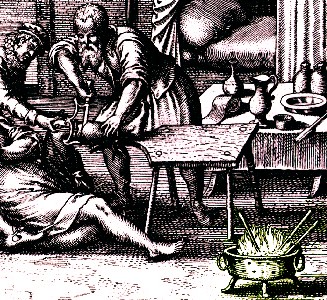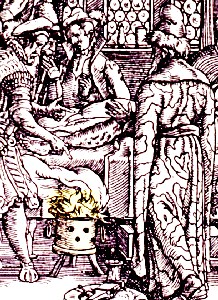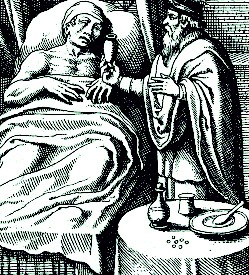
Cauterizing Tools Page Menu: 1 2 3 4 5 6 Next>>
Cauterizing Tools of the Golden Age of Piracy, Page 1
"There was no Surgeon aboard [pirate Capt. John Phillips' ship], and therefore it was advis'd, upon a learned Consultation, that Phillips's Leg should be cut off ...at length the Carpenter [Thomas Fern] was appointed, as the most proper Man. Upon which, he fetch'd up the biggest Saw, and taking the Limb under his Arm, fell to Work, and separated it from the Body of the Patient... after that he heated his Ax red hot in the Fire, and cauteriz'd the Wound, but not with so much Art as he performed the other Part, for he so burnt his Flesh distant from the Place of Amputation, that it had like to have mortify'd, however nature performed a Cure at last without any other Assistance." (Captain Charles Johnson, The General History of the Pyrates, 3rd edition, p. 400-1)

Cauteries Ready During Amputation from De Gangrena et
Sphacelo,. by Willhem Hildanus (1617)
Cauterizing is the surgical act of burning a part of the body to destroy damaged skin or create a burn which seals a bleeding vessel. It is an ancient practice, going back before the time of HIppocrates. Cauterizing reached its peak as a medicinal treatment during the 15th and 16th centuries and began to slowly fall out of favor after that. Elizabeth Bennion tells us that "most surgeons would have had a cautery in their collection. There are several in the seventeenth-century Prujean
Collection ranging in size from a small bead to a lozenge 2.5 cm across. A case of instruments c. 1715 at the R.A.M.C. Museum includes one with a forward curving shaft and a head the shape and size of half a large pea. Percivall Pott [1714-1788] completely abandoned the cautery and such was his example that it virtually passed out of use."1
The golden age of piracy preceded Pott's career, so cauteries were still in use. While many surgeons of this time preferred to use other methods of treatment before cauterizing, they still included irons among their collection of instruments. Sea-surgeon John Woodall explained that "it is very fit [that] the Surgeons chest shall be furnished with divers sorts of them, if the allowance of the Surgeon [space in his chest on the ship] will admit it."2
1 Elizabeth Bennion, Antique Medical Instruments, p. 184-5; 2 John Woodall, the surgions mate, p. 11
Potential vs. Actual Cauteries
There

Debating Cautery Treatment,
from
Paracelsus, Opus Chyrurgicum,
Artzney Buch (1565)
were two very different types of cauteries: caustic chemical agents and metal rods with non-metal handles, which were heated for direct application to the skin. French surgical instructor Pierre Dionis explained,
Cauteries from all Antiquity have been divided into two Species, viz. the Actual and Potential. The first are hot and burning Irons, which cauterize and burn at the very Instant they touch: The other are Compositions of burning Medicaments, of which are made little Stones, which laid on some Places produce a Scar there, which being fallen off, leaves a small deep Ulcer, thro' which the Humours run out as long as we keep it open.1
Although this division was widely agreed upon, instructor Dionis discusses a debate over the difference between the two. "Some Physicians, who would have this Distinction thought merely Chimerical [fanciful], assert, that there are no such things as Potential Cauteries, and that every Cautery is a material one, whose Action is to burn."2 He hints that he agrees, suggesting that the reason most surgeons separate the two types of cautery is mere habit. He explains that this is because surgeons are generally more interested in practical concerns than philosophical ones.
Even so, there is a great deal of debate found in contemporary surgical manuals about which method is better, indicating that there is more than tradition and stubborness behind the division of the two types.
Potential vs. Actual Cauteries: Pro-Potential
Several authors make the case for using potential cauteries, Dionis himself being foremost among them. When advising his readers on ways to stop bleeding during an amputation, he begins by highlighting the problems with actual cauteries,

Author Pierre Dionis
noting that "this cruel way was uncertain, because when the Scar [created by burning the skin] came to fall [off], the Blood flew out with the same Violence as on the Day of the Operation; which has put the Artists of our Profession on the search of gentler ways than that of Fire."3 Rather than use actual cauterizing tools, he recommends using a potential cauterizing 'button', "which is made of a little bit of broken Vitriol [copper sulfate] wrapt up in a little Cotton... [it] burns and cauterizes wherever it touches, and by the Scar which it makes stops the Blood; This is the Method us’d at the Hotel-Dieu at Paris [a famous French hospital] in all Amputations."4 He later suggests that "Potential Cauteries are more in use; and we draw great Advantages from them to inveterate Distempers, after having in vain made use of other Remedies"5.
Another French author, Jacques Guillemeau, noted that sugeons "most commo[n]lye they use the potentialle consideringe the seare [burn], & affrightednes, which the Patientes conceave therofe, soe that the actuall Cauteryes are allmost therthoughe relapseded into oblivione"6. He goes on to reveal that potential cauteries are "verye excelle[n]t, & where I of never as yet knewe anye badde accident to followe, through the longe use wherof, we have learned the certayntye howe to make them."7
Sea surgeon John Woodall says that potential cauteries are 'convenient'8. While this sounds like faint praise, it is actually rather telling. In his books on sea surgery, John Moyle rarely advises the use of the actual cautery. This was probably not because he believed potential cauteries are better, but because "by no means do I like fire on a Platform in time of Fight" because if it tipped over, it "hazarded the burning of the Ship."9
Potential vs. Actual Cauteries: Pro-Actual Cautery
Other period and near-period authors preferred actual cautery over potential. Foremost among them was military surgeon Richard Wiseman. When discussing the treatment of carbuncles, Wiseman explained that "Some Authors have proposed the Caustick [potential cautery]. Without a doubt the actual Cautery timely applied on some of them would save the Patient much pain, and shorten the Cure, for the malignity being thereby consumed, the Escar might without much difficulty be digested"10. After dismissing potential cauteries in his treatise on treatment of gangrene, Wisman explained,
Whereas on the contrary, an actual Cautery answers all Intentions: It not only consumeth the Mortification, but drieth up the venomous Humour, thereby preventing its farther progress; and also communicateth warmth to the languishing Parts, by virtue of which the Separation is much fathered, and by working upon the gangrened Sloughs [dead skin] performed more easily, as you may see in my Practice elsewhere.11

Military Surgery Author Richard Wiseman
It is notable that Wiseman refers to humor theory, which suggests that wounds are focal points for bad humors, which gather there and make wound cure more difficult. Humors were represented by things such as 'bad' blood and pus. Wiseman's belief is that the chemical compounds would not remove these bad humors, while a hot iron would burn them away and dry them up.
French surgeon Ambroise Paré also preferred actual cauteries "because by strengthening the part [they burn], they consume the excrementiolus humors wherewith it is over-charged, to wit, the matter of the Caries [decayed bone]; which is not so effectually performed by potential Cauteries."12
While Jacques Guillemeau was shown to be a proponent of potential cauteries in the previous section also puts in a good word for the actual cautery, calling it "much convie[n]ter, then the Potentiall"13. Guillemeau gives an extensive list of reasons to use actual cauteries, finding them to be more certain and healthy in operation, able to dry up the humors, more controllable in terms of the depth of the cautery as well as not "causing anye accidentes in the circumjacent partes"14. He finds actual cauteries to be an "enimye unto all corruption, wherfor, it freethe alsoe from all corruptione, & putrefactione, yea it consumeth all venoumouse matter, & quallityes, which in that parte might lye occulted, and hidden, consumeth also all superfluouse humidityes, and correcteth alsoe all untemperate coulde, and moysture."15 This again hearkens to the destruction of humors, although Guillemeau does not call them that.

A Patient Lannguishing, From De Efficaci
Medicina Libri Rres, by Marco Aurelio
Severino, Title Page (1646)
He notes that potential cauteries, on the other hand, are often venomous by nature, poisoning the part they touch. Guillemeau suggests that they are "uncertayne, retardate, and slowe"16. Because they sometimes burn with less precision, they "causeth more detriment, and harme in corrosione, then willingly we woulde, it shoulde, because it doth not only combute & burne the place whereone it is applyed"17. Guillemeau finds that the uncontrollable nature of potential cauteries sometimes lead to "verye badde accidentes, and ulcerations," which are difficult to cure and can even become gangrenous.18
In a similar manner, one of the sea surgeons recommends against potential cauteries. John Atkins finds "potential Cauteries are less eligible, as their Effects are more tragical; they gnaw and corrode on the Ends of the Nerves and Tendons, and so insinuate and spread their Malignity, that you never fail of extreme Pain from them, a large Synovia [opening in the skin], and too often Fevers, Convulsions and Death"19.
So a case could be made for either type of cautery from a golden age of pyracy surgeon's point of view. With this in mind, let's look at both of these types of cauterizing tools in more detail.
1 Pierre Dionis, A course of chirurgical operations: demonstrated in the royal garden at Paris. 2nd ed., p. 467; 2 Dionis, ibid.; 3 Dionis, p. 408; 4 Dionis, ibid.; 4 Dionis, p. 468; 6 Jacques Guillemeau, The French Chirurgerie, p. 41; 7 Guillemeau, ibid.; 2 John Woodall, the surgions mate, p. 232; 9 John Moyle, Abstractum Chirurgæ Marinæ, p. 25-6; 10 Richard Wiseman, Eight Chirurgicall Treatises, 3rd Edition, p. 53; 11 Richard Wiseman, Of Wounds, Severall Chirurgicall Treatises, p. 450; 12 Ambroise Paré, The Workes of that Famous Chirurgion Ambrose Parey, p.485; 13, 14, 15, 16, 17, 18 Guillemeau, ibid.; 19 John Atkins, The Navy Surgeon, p. 121

